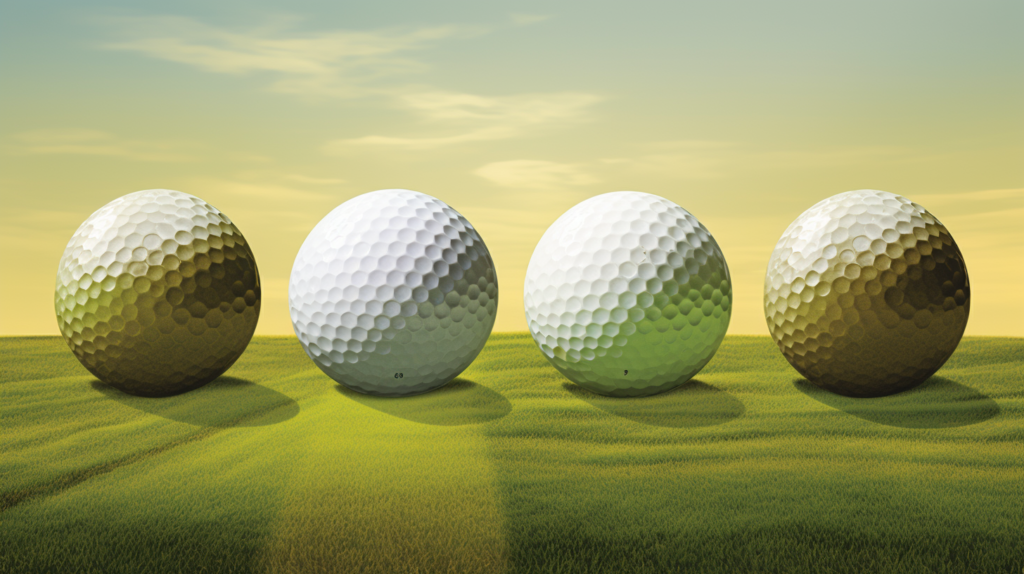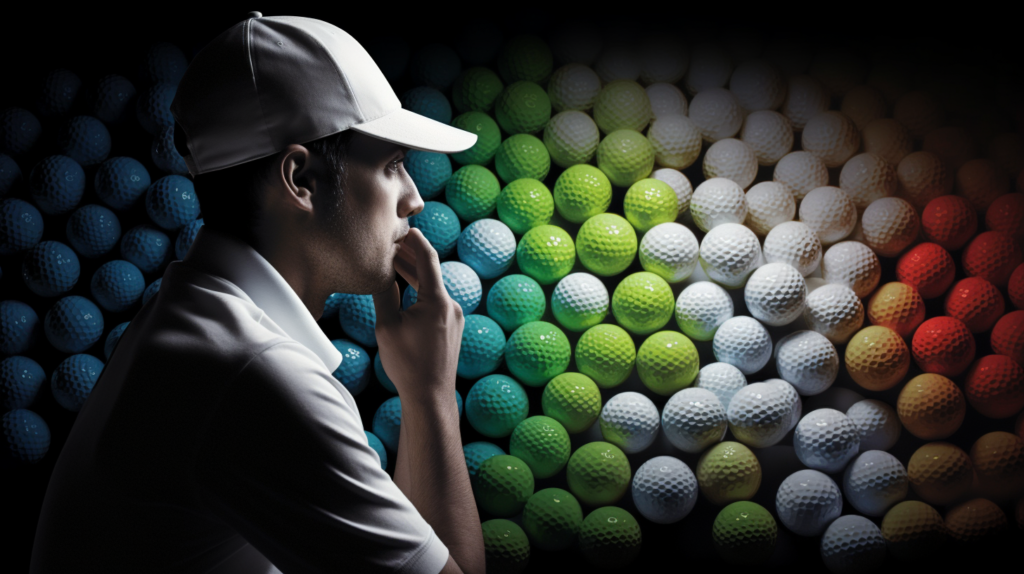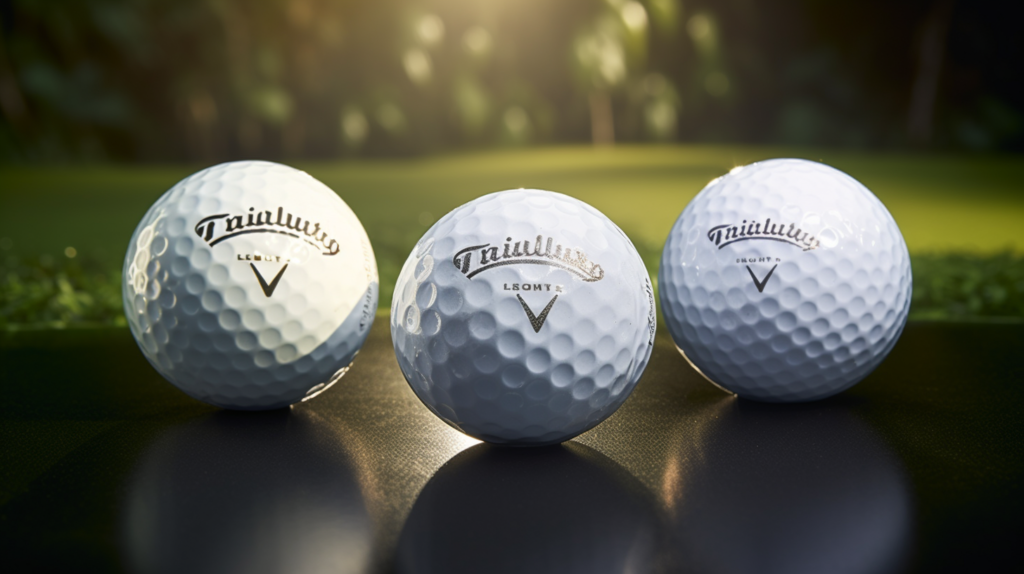With so many golf balls claiming longer drives or spin control, making the best choice for your game can prove daunting.
Understanding key selection factors based on your skills and finding balls engineered for your ability level leads to peak performance.
Let’s dive in to determine what golf ball you should use by examining decision considerations, construction types, and tailored brand recommendations for all player categories.
Factors To Consider When Choosing A Golf Ball

When selecting a golf ball, there are several key factors you need to take into account depending on your individual game, skill level, and preferences on the course. Understanding these factors will help guide you to pick the right ball that matches your strengths as a player.
The main considerations when choosing a golf ball include your skill level, swing speed, a preference for distance or control, the softness/hardness you like, dimple pattern, and price point you are aiming for.
Weighing all these variables against each other will lead you to the ideal golf ball for how you specifically play the game.
Your Skill Level As A Golfer
The first aspect to think about is your general skill level in golf. Complete beginners will need a very forgiving ball that helps compensate for lack of technique.
Intermediate players need a ball for average ability that combines distance with some spin and feel. Advanced golfers pursuing low scores require a high-performance ball to maximize their shot-making skill.
Skill level connects closely to factors like swing speed. But it serves as a good overall benchmark for zeroing in on balls best suited for you.
Being realistic about current golfing ability matters greatly in getting equipment that enhances your play rather than hinders it. Do not choose touring pro-level balls if you are just learning the game.
Conversely, avoid very basic balls if you make solid contact and have repeatability in irons and drives. Matching skill competency with the right ball will make a big difference in scoring and satisfaction.
Determining Your Swing Speed
Swing speed indicates how fast your club head travels right before striking the ball. This directly impacts the compression of the golf ball needed to optimize distance and accuracy.
Slower swing speeds under 90 mph will not compress a firmer ball, resulting in shorter shots.
Before buying new balls, have your swing speed measured by a launch monitor, golf pro, or swing speed radar. Alternatively, examine your typical yardages and trajectory to estimate speed.
This knowledge will assist substantially in narrowing down ball selection.
If your swing clocks below 90 mph, look for softer balls of 50-75 compression, as they are easiest to compress on slower impact. Swing speeds from 90-110 mph benefit from mid-compression balls of around 80.
For tour-level swing speeds over 110 mph, firmer balls with 90+ compression are best to harness maximum energy transfer.
Distance vs Control In A Golf Ball
Golf balls are engineered to produce either maximum possible distance or promote higher control and spin around the greens. As you evaluate different models, determine whether steady distance or manipulative finesse fits your game better.
If you depend heavily on length off the tee and do not shape many shots, a distance ball will maintain trajectory and roll. These typically have surlyn covers and lower compression cores.
If creative shot-making is integral to your scorecard, choose a ball with urethane cover and extra layers to increase spin and stopping ability.
Analyze if you tend to struggle more with accuracy, distance, or the short game. Then gravitate toward features benefiting your weakest area while preserving adequate performance in other facets.
Keep distance vs control trade-offs in mind so you choose what is suitable.
Softness And Hardness Levels
Golf ball covers and cores contain varying hardness or softness levels that affect feel and resilience. Softer balls feel better clubface contact and generate more spin, while firmer ones fly farther and resist ballooning on mishits.
Determining your preferences here will filter selections.
If you desire very soft feel with keen feedback and checker spin, balls like the Titleist Pro V1 or Callaway Chrome Soft have urethane covers and low-compression cores. For moderate softness combined with lower driver spin and longer carries, the Srixon Z-Star XV works well.
Maximum distance over soft feel? Then firmer surlyn-covered balls such as Titleist’s Velocity or Callaway’s Supersoft offer affordable consistency there. Dial in softness vs firmness feels to identify the most pleasing and effective ball.
Evaluating Dimple Patterns
The dimple design imprinted on the ball surface greatly dictates overall aerodynamics. Different dimple quantities, depths, and symmetry alter drag levels to impact sustain distance and stability.
When comparing models, look into their dimple patterns.
Balls like the Bridgestone E6 minimize drag for a penetrating, straight flight while others such as the Callaway Chrome Soft feature greater surface friction to heighten shot curves and apex heights.
Whether you want a boring trajectory or more variable ball flight, considering dimple scheme aids selections.
Most brands now optimize dimples for ideal lift to drag ratios. But some lean slightly more towards drag reduction or purposely boost turbulence.
Discover what patterns align best with your typical shot tendencies when reading ball reviews.
Setting Your Golf Ball Budget
Lastly, the price point you wish to stay within will filter selections down further. Tour-quality balls with multi-layer ionomer designs retail highest, normally $45-50 per dozen.
They offer the most advanced engineering and materials for skilled players.
Mid-price distance or soft-feel models around $30 per dozen provide very solid performance for average ability levels. And entry-level balls from top brands run $20 or under per dozen for newbies, with emphasis on affordability over peak quality.
Determine what price threshold leaves you with acceptable value for money spent. Avoid overspending just for a premium name when models 1-2 tiers lower match your skills well.
And steer clear of the cheapest no-name balls lacking reliability. Setting budget filters helps identify sensible options.
Golf Ball Types

There are four common category types of golf ball constructions on the market. Each has specialized traits catering to certain playing styles and swing speeds.
Learning the differences will make your selection process more straightforward.
The four main golf ball types are two-piece, three-piece, four/five-piece, and lower compression options. We will analyze the characteristics of each to showcase suitable skill levels and playing profiles.
Use this education to direct you to models that fit your game best.
Benefits Of Using Two-Piece Golf Balls
The two-piece construction features a surlyn or similar cover material over a solid core, resulting in firmer feel and faster balls speeds. These rank among the most affordable and durable choices, plus display lower driver and iron spin for maximum distance potential.
Two-piece balls work optimally for beginners or high handicaps as their sturdy builds allow for more mishit forgiveness. Slow and moderate swing speeds below 100 mph also gain valuable yards with the two-piece’s low spin, high launch, and carry capacity.
If you regularly struggle making solid contact or lack distance with other balls, two-piece is an excellent place to start. Leading models in this category include the Titleist DT TruSoft, Callaway Supersoft, Srixon Soft Feel, and Bridgestone E6 Soft.
Stay under $20 per dozen for quality here.
Combining Distance And Feel In Three-Piece Balls
Moving up a layer, three-piece golf balls add an extra coating between the cover and core to begin balancing distance and softness. This produces medium spin rates along with responsive feel and control on full shots.
Average golfers with improving technical skills reap great utility from three-piece balls. Their dual distance and feel suits swing speeds around 90-100 mph very well.
You compromise minimally on either while getting better reliability than basic two-piece models.
Notables in the three-piece segment span Callaway’s Chrome Soft, TaylorMade’s Project (a), Titleist’s Velocity, and Vice’s Pro Plus. These retail mostly in the $25-30 per dozen range for impressive intermediary qualities.
Maximizing Spin And Control With Four/Five-Piece Balls
The premier echelon of golf balls utilizes four or five-piece layering with soft urethane covers to supply maximum spin control and refined feel. Their multi-component designs enable shaping various shots while optimizing driver distances.
Advanced players use four and five-piece balls to lower scores by fine-tuning trajectory, curving ball flights, and sticking greens with precision. The urethane covers grab wedge and short iron grooves aggressively for expert-level spin and stopping ability.
Because these balls have the highest material and construction costs, prices hit $45 per dozen or more. But for golfers with 4 handicaps or better, the Titleist Pro V1/Pro V1x, TaylorMade TP5/TP5x or Callaway Chrome Soft X provide stellar performance improvements.
Lower Compression Balls
Two-piece distance balls discussed earlier can also come in lower 50-75 compression formats built exceptionally soft. These excessively compress even on slower swings below 90 mph to achieve maximum velocity and distance for straight shots.
Seniors, women, beginners, or anyone requiring extra yardage from compression boosts will benefit from lower compressed two-piece balls. Key examples are the Bridgestone E6 Soft, Precept Laddie X, and Titleist’s DT TruSoft line with their softCompression cores.
Focusing on lower compression as needed unlocks higher ball speeds, better energy transfers, and forgiveness on mishits. Do not overlook this category when distance and compression suit you more than spin and greenside work.
Key Brands & Models

Now we will recommend specific golf ball models categorized into price tiers based on prominent brands’ selections. These encompass picks spanning lower/higher handicaps, swing speeds, spin rates to suit differing games.
Premium Balls For Advanced Players And Low Handicaps
If your budget allows, treat yourself to four and five-piece tour-caliber balls engineered for golfers with elite swing speeds and spin control. They demand a high price but unlock mastery shot-making.
The Titleist Pro V1 and Pro V1x ($47 per dozen) remain legendary benchmarks, blending outrageous distance with sublime short-game spin via soft urethane covers and sophisticated cores. TaylorMade’s TP5 and TP5X ($45) now rival those, tweaking designs for personalization.
Callaway’s Chrome Soft X ($40) is another entrant packing speeds like firmer models but feel of softer balls. And Srixon’s Z-Star XV ($40) fires high trajectories with lower driver spin plus great stopping power.
Go premium if desire and ability justify costs.
Intermediate Soft-Feel Distance Balls
For mid-handicaps and moderate swing speeds, quality three-piece distance or soft-feel balls enhance play at friendlier budgets. These feature adjustable cores inside ionomer or urethane covers for ideal mid-level compression, drive length and short-game work.
Callaway Chrome Soft ($35) leads the soft-feel charge with a Graphene-infused dual core for extreme distance gains, plus urethane cover tackiness around greens.
Bridgestone’s E6 Soft ($30) simplifies adjustments for hitting straighter via a gradation core and soft surlyn for forgiveness.
Titleist TruFeel ($22) permeates the category with TruTouch cover for short-game spin and redesigned core boosting longer clubs. And Srixon Soft Feel ($25) nails durable feel via energetic gradient core and soft ionomer cover.
Basic Two-Piece Distance Balls
Newer players on a strict budget should choose two-piece distance balls focused purely on faster swing speeds below 100 mph. Surlyn covers and high-energy solid cores translate to longer carries and more total yards when you make decent contact.
Callaway Supersoft Magna ($20) compresses high on slower impacts for effortless speed, its Magnagroove cover promoting reduced drag and sustaining ball velocity.
Meanwhile Titleist DT TruSoft ($20) redeems solid straight drivers via ultra-plush TruSoft cover and low-compression core.
Even cheaper but consistent, Srixon’s Soft Feel Lady ($17) avails low-compression engine within soft ionomer skin for smooth acceleration. And Vimble’s Lifeline ($15) surprises further, its three-piece construction not restricting beginner distance or feel.
Whichever you choose, spend smartly.
Conclusion
Finding the right golf ball truly comes down to analyzing your personal skills and preferences then matching with the ideal construction features.
Whether you seek maximum greenside control, softer feel, or sheer yards off the tee, selecting balls aligned with your game can lower scores.
Weigh all the decision factors covered today, narrow choices by type and price, and experiment with top models to discover your ideal ball. Improved golf shots await you.



